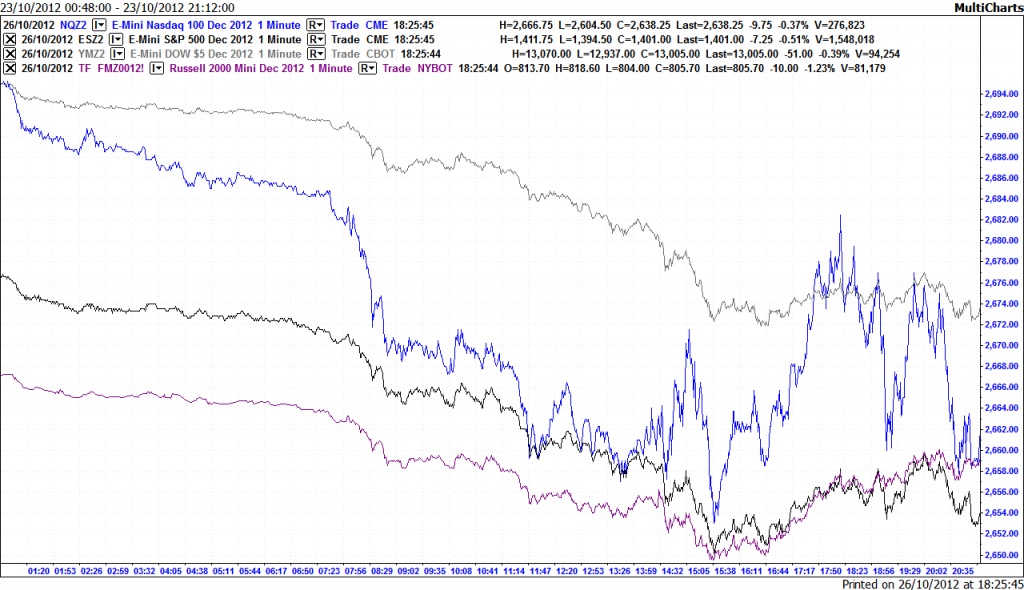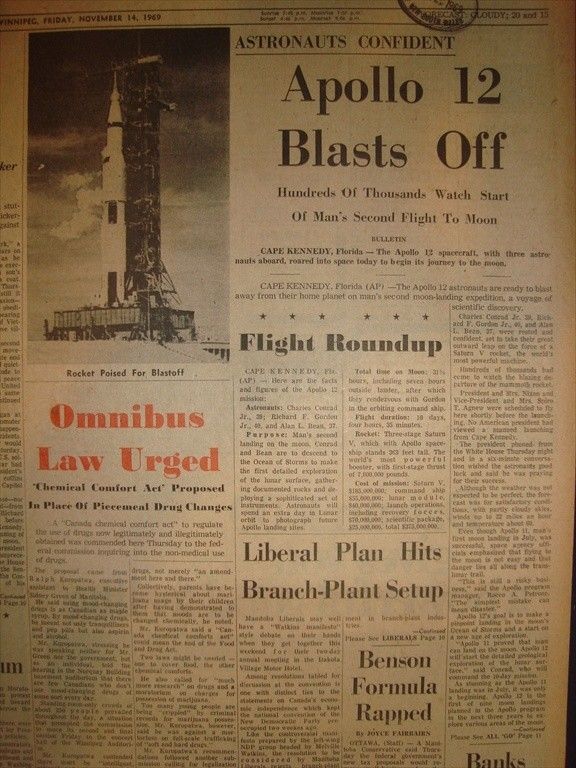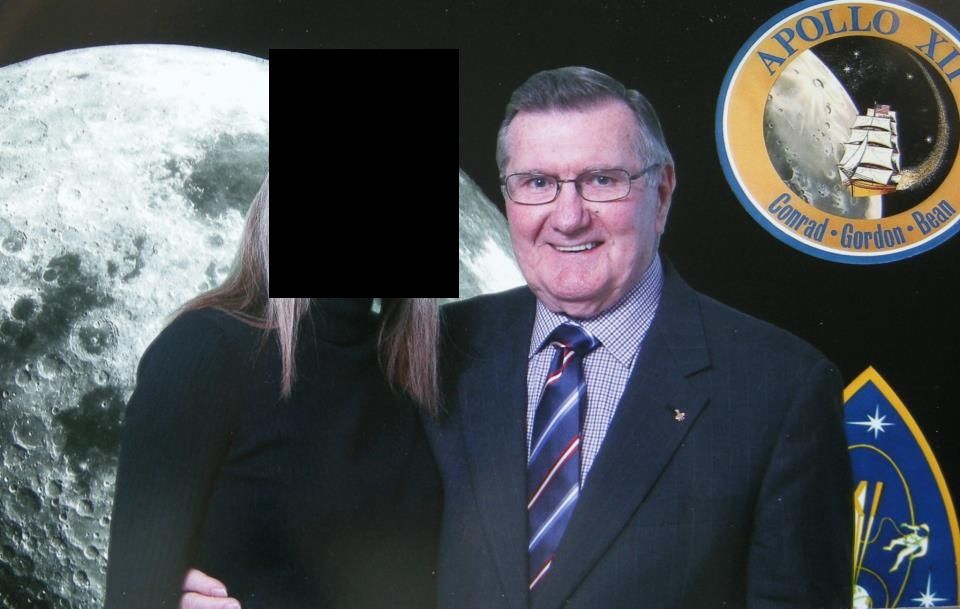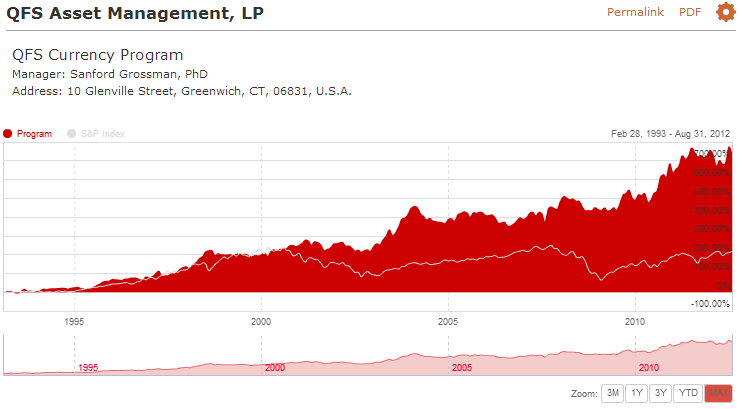I'm exploring the idea of trading spreads right now, so for example long NASDAQ futures / short DOW futures, that sort of thing.
During my previous efforts there were a few things I picked up from watching the markets regularly, that I may be able to capitalise on. There are some patterns that occur between equity markets and currency markets that could be traded.
Let's find out.
 Clearly there are a different set of risks and opportunities compared to the type of trading I was previously engaged in so I'll need to study this for a while, probably once I've developed a basic strategy I will test it out on a simulated account first, to see how I get on. There are some attractive aspects, such as your position being hedged all the time, even if it's not a full hedge, and no stops would be involved, so the entry probably would not need to be so finessed as compared to my previous strategy (Strategy II), although I would probably still set emergency stops well wide of the market, just in case something adverse happened, certainly on the long leg of the spread anyway.
Here's one I made earlier - up so far.
E-MIni NASDAQ futures
The Spread
E-mini Dow Futures
Clearly there are a different set of risks and opportunities compared to the type of trading I was previously engaged in so I'll need to study this for a while, probably once I've developed a basic strategy I will test it out on a simulated account first, to see how I get on. There are some attractive aspects, such as your position being hedged all the time, even if it's not a full hedge, and no stops would be involved, so the entry probably would not need to be so finessed as compared to my previous strategy (Strategy II), although I would probably still set emergency stops well wide of the market, just in case something adverse happened, certainly on the long leg of the spread anyway.
Here's one I made earlier - up so far.
E-MIni NASDAQ futures
The Spread
E-mini Dow Futures

I recently met Captain Richard Frances Gordon, former NASA astronaut and one of only 24 people who have travelled to the moon. He was part of the Gemini 11 and Apollo 12 missions.
There he is, in the middle;

 He gave an excellent talk, one I'm sure he's given many times over, and his final message was about risk. He explained that many people are afraid to take risks, discourage their children from taking risks etc but that is how people come to achieve great things, by taking risks, so his parting message was to parents of children, encourage them to take risks, as it's only by doing that, that we can achieve anything and it's ok to fail since sometimes you need to fail at something to learn enough to conquer it the next time. He did a spacewalk during his November 1969 mission but he failed at the task he'd been given, simply because they hadn't though of designing something to hold his feet to leave his hands free to carry out a task in space. Consequently he had to hold on with one hand and try and use the other to complete a 2 handed task! He referred to himself as a failure for that particular element but NASA learned from that for future missions and implemented new designs to account for these difficulties.
I found his talk quite inspiring, there was a big que at the end so that everyone could get a piece of him, either a picture or signature (or both!).
I just shook his hand, told him talk was great, and thanked him.
The mission insignia;
He gave an excellent talk, one I'm sure he's given many times over, and his final message was about risk. He explained that many people are afraid to take risks, discourage their children from taking risks etc but that is how people come to achieve great things, by taking risks, so his parting message was to parents of children, encourage them to take risks, as it's only by doing that, that we can achieve anything and it's ok to fail since sometimes you need to fail at something to learn enough to conquer it the next time. He did a spacewalk during his November 1969 mission but he failed at the task he'd been given, simply because they hadn't though of designing something to hold his feet to leave his hands free to carry out a task in space. Consequently he had to hold on with one hand and try and use the other to complete a 2 handed task! He referred to himself as a failure for that particular element but NASA learned from that for future missions and implemented new designs to account for these difficulties.
I found his talk quite inspiring, there was a big que at the end so that everyone could get a piece of him, either a picture or signature (or both!).
I just shook his hand, told him talk was great, and thanked him.
The mission insignia;
 Of course my wife wanted a picture with him, (I don't think she would appreciate me posting so I've "amended" the picture).
Oh yes, Captain Richard Gordon liked my wife alright! Still an eye for the ladies at 83!
Of course my wife wanted a picture with him, (I don't think she would appreciate me posting so I've "amended" the picture).
Oh yes, Captain Richard Gordon liked my wife alright! Still an eye for the ladies at 83!

I've spent the last 9.5 hours trying to develop a different way to analyse securities, it's been a real slog. It may not be new (since you don't know what others are up to) but it certainly has to be at least 3 standard deviations away from the mean, the mean being the somewhat typically archaic methods that the mass market uses. Searches on Google turn a blank. What I'm try to do is find a way to exploit the human tendency to look at things in pairs, or in contrast to one another. It's a natural direction for people to take, in terms of their thinking and I'm sure that it must have left a gap in the market that can be exploited.
Some probably think this is not normal behaviour for a saturday, maybe I should be watching a group of men kick an inflated leather ball amongst themselves with the object of scoring a "goal" or perhaps swinging a club with the object of getting the ball in the hole, or playing with a cue with the object of getting the balls in the holes.
The truth is the financial markets are far more competitive than those silly games, and a whole lot more interesting.
Found an interesting website www.absolutereturns.com;"Absolute Returns, founded in 2007, is an independent managed futures and alternative investment performance database for both individual investors and brokers. Managers report to our database directly.You can look at various funds, CTA's etc, it's quite interesting looking at their historic equity curve and their disclosure docs that details the strategy employed.Here's one that stands out; The background of the manager also stands out;"Sanford J. Grossman earned his B.A. in 1973, M.A. in 1974 and PhD in 1975, all in Economics, from the University of Chicago. Since receiving his doctorate, he has held academic appointments at Stanford University, the University of Chicago, Princeton University (as the John L. Weinberg Professor of Economics, 1985-89) and at the University of Pennsylvania's Wharton School of Business. At Wharton, Dr. Grossman held the position of Steinberg Trustee Professor of Finance from 1989 to 1999 (a title now held in Emeritus) and also served as the Director of the Wharton Center for Quantitative Finance (1994 - 1999). In addition, Dr. Grossman was an Economist with the Board of Governors of the Federal Reserve System (1977-78), and was a Public Director of the Chicago Board of Trade (1992-96). In 1988, he was elected a Director, in 1992 served as Vice President, and in 1994 was President of the American Finance Association.
The background of the manager also stands out;"Sanford J. Grossman earned his B.A. in 1973, M.A. in 1974 and PhD in 1975, all in Economics, from the University of Chicago. Since receiving his doctorate, he has held academic appointments at Stanford University, the University of Chicago, Princeton University (as the John L. Weinberg Professor of Economics, 1985-89) and at the University of Pennsylvania's Wharton School of Business. At Wharton, Dr. Grossman held the position of Steinberg Trustee Professor of Finance from 1989 to 1999 (a title now held in Emeritus) and also served as the Director of the Wharton Center for Quantitative Finance (1994 - 1999). In addition, Dr. Grossman was an Economist with the Board of Governors of the Federal Reserve System (1977-78), and was a Public Director of the Chicago Board of Trade (1992-96). In 1988, he was elected a Director, in 1992 served as Vice President, and in 1994 was President of the American Finance Association.
Dr. Grossman's research has spanned the analysis of information in securities markets, corporate structure, property rights, and optimal dynamic risk management. He has published widely in leading economic and business journals, including American Economic Review, Journal of Econometrics, Econometrica and Journal of Finance. His papers include "The Existence of Futures Markets, Noisy Rational Expectations and Information Externalities"; "On the Efficiency of Competitive Stock Markets Where Traders Have Diverse Information"; "On the Impossibility of Informationally Efficient Markets," with Joseph Stiglitz; "An Introduction to the Theory of Rational Expectations Under Asymmetric Information"; and "The Costs and Benefits of Ownership: A Theory of Vertical Integration," with Oliver Hart. Dr. Grossman's original contributions to economic research received official recognition when he was awarded the John Bates Clark Medal by the American Economic Association at its December 1987 annual meeting. The Q-Group awarded him first prize in The Roger F. Murray Prize competition for the paper "An Analysis of the Implications for Stock and Futures Price Volatility of Program Trading and Dynamic Hedging Strategies." The Editorial Board of the Financial Analysts Journal awarded him the 1988 Graham and Dodd Scroll for "Program Trading and Market Volatility: A Report on Interday Relationships." Dr. Grossman received a Mathematical Finance 1993 Best Paper Award for his article "Optimal Investment Strategies for Controlling Drawdowns." Dr. Grossman received the 1996 Leo Melamed Prize by the University of Chicago Graduate School of Business for outstanding scholarship by a professor. In 2002, Dr. Grossman was recognized by the University of Chicago with its Professional Achievement Citation. Most recently, he was awarded the 2009 CME Group-MSRI Prize in Innovative Quantitative Applications. Currently, Dr. Grossman applies his rigorous scientific approach to improving and developing systematic investment strategies and risk controls for QFS."$811 Mill assets under managemnt, minimum investment $250K. Counts me out.
Links between fluid intelligence and creative thought explored in the following paper;http://scottbarrykau...lvia-Beaty-.pdfa b s t r a c tThe relationship between intelligence and creativity remains controversial. The present researchexplored this issue by studying the role of fluid intelligence (Gf) in the generation ofcreative metaphors. Participants (n=132 young adults) completed six nonverbal tests of Gf(primarily tests of inductive reasoning) and were then asked to create metaphors that describeda past emotional experience. The metaphors were rated for creative quality. Latent variablemodels found that Gf explained approximately 24% of the variance in metaphor quality(standardized beta=.49), consistent with the view that creative ideation engages executiveprocesses and abilities. The effect of Gf remained substantial after including personality (theBig Five factors) in the model. The discussion considers implications for the debate over intelligenceand creativity as well as for the cognitive abilities involved in metaphor production.© 2012 Elsevier Inc. All rights reserved.
For anyone more interested in the Dual N back study, you can try out the task it's based on here http://www.memory-im...k-training.html






